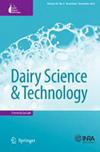Functional and Safety Characterization of Weissella paramesenteroides Strains Isolated from Dairy Products through Whole-Genome Sequencing and Comparative Genomics
Q2 Agricultural and Biological Sciences
引用次数: 7
Abstract
Strains belonging to the Weissella genus are frequently recovered from spontaneously fermented foods. Their functional, microbial-modulating, and probiotic traits enhance not only the sensorial properties but also the nutritional value, beneficial effects, and safety of fermented products. Sporadic cases of opportunistic pathogenicity and antibiotic resistance have deprived safety status from all Weissella species, which thus remain understudied. Our study increased the number of available high-quality and taxonomically accurate W. paramesenteroides genomes by 25% (9 genomes reported, leading to a total of 36 genomes). We conducted a phylogenetic and comparative genomic analysis of the most dominant Weissella species (W. cibaria, W. paramesenteroides, W. viridescens, W. soli, W. koreensis, W. hellenica and W. thailadensis). The phylogenetic tree corroborated species assignment but also revealed phylogenetic diversity within the Weissella species, which is likely related to the adaptation of Weissella in different niches. Using robust alignment criteria, we showed the overall absence of resistance and virulence genes in Weissella spp., except for one W. cibaria isolate carrying blaTEM-181. Enrichment analysis showed the association of Weissella species several CAZymes, which are essential for biotechnological applications. Additionally, the combination of CAZyme metabolites with probiotics can potentially lead to beneficial effects for hosts, such as the inhibition of inflammatory processes and the reduction of cholesterol levels. Bacteriocins and mobile genetic elements MGEs (Inc11 plasmid and ISS1N insertion sequence) were less abundant, however W. thailadensis and W. viridescens showed significant association with specific bacteriocin-encoding genes. Lastly, an analysis of phenotypic traits underlined the need to carefully evaluate W. cibaria strains before use as food additives and suggested the possibility of employing W. paramesenteroides and W. hellenica in the fermentation process of vegetable products. More studies providing high-resolution characterization of Weissella strains from various sources are necessary to elucidate the safety of Weissella spp. and exploit their beneficial characteristics.通过全基因组测序和比较基因组学研究乳制品中魏氏副小肠杆菌的功能和安全性
属于魏塞拉属的菌株经常从自发发酵的食物中恢复。它们的功能、微生物调节和益生菌特性不仅提高了发酵产品的感官特性,而且提高了发酵产品的营养价值、有益效果和安全性。零星的机会致病性和抗生素耐药性病例剥夺了所有韦塞尔菌种的安全地位,因此仍未得到充分研究。我们的研究使现有的高质量和分类准确的副肠弧菌基因组数量增加了25%(报道了9个基因组,使总数达到36个基因组)。我们对最具优势的魏氏种(W. cibaria, W. paresenteroides, W. viridowns, W. soli, W. koreensis, W. hellenica和W.泰国)进行了系统发育和比较基因组分析。系统发育树不仅证实了物种分配,而且揭示了不同种间的系统发育多样性,这可能与不同生态位的适应有关。使用强大的比对标准,我们发现Weissella spp.总体上缺乏抗性和毒力基因,除了一株携带blatem1 -181的西baria W.分离物。富集分析表明,Weissella种中存在多种cazyme,这对生物技术应用具有重要意义。此外,CAZyme代谢物与益生菌的结合可能会对宿主产生有益的影响,例如抑制炎症过程和降低胆固醇水平。细菌素和移动遗传元件MGEs (Inc11质粒和ISS1N插入序列)的丰度较低,但泰国芽孢杆菌和病毒下降芽孢杆菌与特定的细菌素编码基因有显著的相关性。最后,表型性状分析强调了在作为食品添加剂使用前需要仔细评估的必要性,并提出了在蔬菜产品发酵过程中使用副肠杆菌和希腊芽孢杆菌的可能性。需要更多的研究提供来自不同来源的魏氏菌的高分辨率特征,以阐明魏氏菌的安全性并开发其有益特性。
本文章由计算机程序翻译,如有差异,请以英文原文为准。
求助全文
约1分钟内获得全文
求助全文
来源期刊

Dairy Science & Technology
农林科学-食品科技
CiteScore
2.30
自引率
0.00%
发文量
0
审稿时长
2 months
期刊介绍:
Information not localized
 求助内容:
求助内容: 应助结果提醒方式:
应助结果提醒方式:


